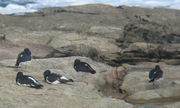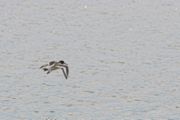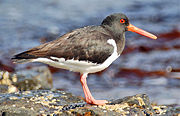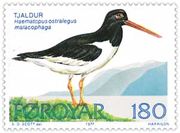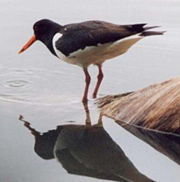Eurasian Oystercatcher
2008/9 Schools Wikipedia Selection. Related subjects: Birds
| Eurasian Oystercatcher | ||||||||||||||
|---|---|---|---|---|---|---|---|---|---|---|---|---|---|---|
 |
||||||||||||||
| Conservation status | ||||||||||||||
| Scientific classification | ||||||||||||||
|
||||||||||||||
| Binomial name | ||||||||||||||
| Haematopus ostralegus Linnaeus, 1758 |
||||||||||||||
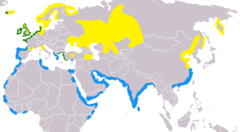 Eurasian Oystercatcher range. Yellow = summer only, blue = winter only, green = all-year resident.
|
The Eurasian Oystercatcher Haematopus ostralegus, also known as the Common Pied Oystercatcher, or (in Europe) just Oystercatcher, is a wader in the oystercatcher bird family Haematopodidae. It is the most widespread of the oystercatchers, with three races breeding in western Europe, central Eurasia, Kamchatka, China, and Western coast of Korea. No other oystercatcher occurs within this area.
This is a migratory species over most of its range. The European population breeds mainly in northern Europe, but in winter the birds can be found in north Africa and southernmost Europe. Although the species is present all year in Ireland, Great Britain and the adjacent European coasts, there is still migratory movement: for example the large flocks that are found the estuaries of south-west England in winter mainly breed in northern England or Scotland. Similar movements are shown by the Asian populations. The birds are highly gregarious outside the breeding season.
These are large obvious and noisy plover-like birds, with black and white plumage, red legs and strong broad red bills used for smashing or prising open molluscs such as mussels or for finding earthworms. Despite its name, oysters do not form a large part of its diet, but few if any other wading birds are capable of opening oysters at all.
The bill shape varies; oystercatchers with broad bill tips open molluscs by prising them apart or hammering through the shell, whereas pointed-bill birds dig up worms. Much of this is due to the wear resulting from feeding on the prey. Thus when birds move inland to breed and thus shift from feeding on molluscs to worms their bill shape changes from flat to pointed.
This oystercatcher is unmistakable in flight, with white patches in the wings and tail, otherwise black upperparts, and white underparts. Young birds are browner, have a white neck collar, and a duller bill. The call is a distinctive loud piping.
The nest is a bare scrape on pebbles, on the coast or on inland gravelly islands. 2-4 eggs are laid. Both eggs and chicks are highly cryptic.
Because of its large numbers and readily identified behaviour, the Oystercatcher is an important indicator species for the health of the ecosystems where it congregates. Extensive long-term studies have been carried out on its foraging behaviour, in northern Germany, in the Netherlands and particularly on the River Exe estuary in south-west England, and these form an important part of the foundation of the modern discipline of behavioural ecology. The Oystercatcher is the national bird of the Faroe Islands.
Subspecies
There are three races the nominate race found in Europe and the coasts of eastern Europe. The race longipes is found in central Asia and Russia while race osculans is found from Kamchatka to northern China.
Bill length shows clinal variation with an increase from west to east. The race longipes has very brownish upperparts and the nasal groove extends more than half-way along the bill. In race ostralegus the nasal groove stops short of the half-way mark. Race osculans lacks white on the shafts of the outer 2-3 primaries and has no white on the outer webs of the outer five primaries.
